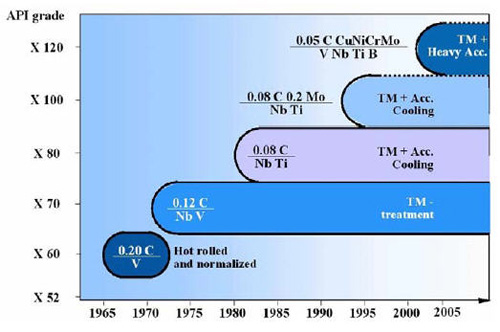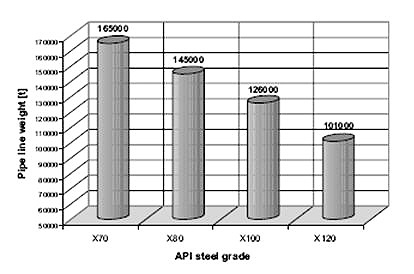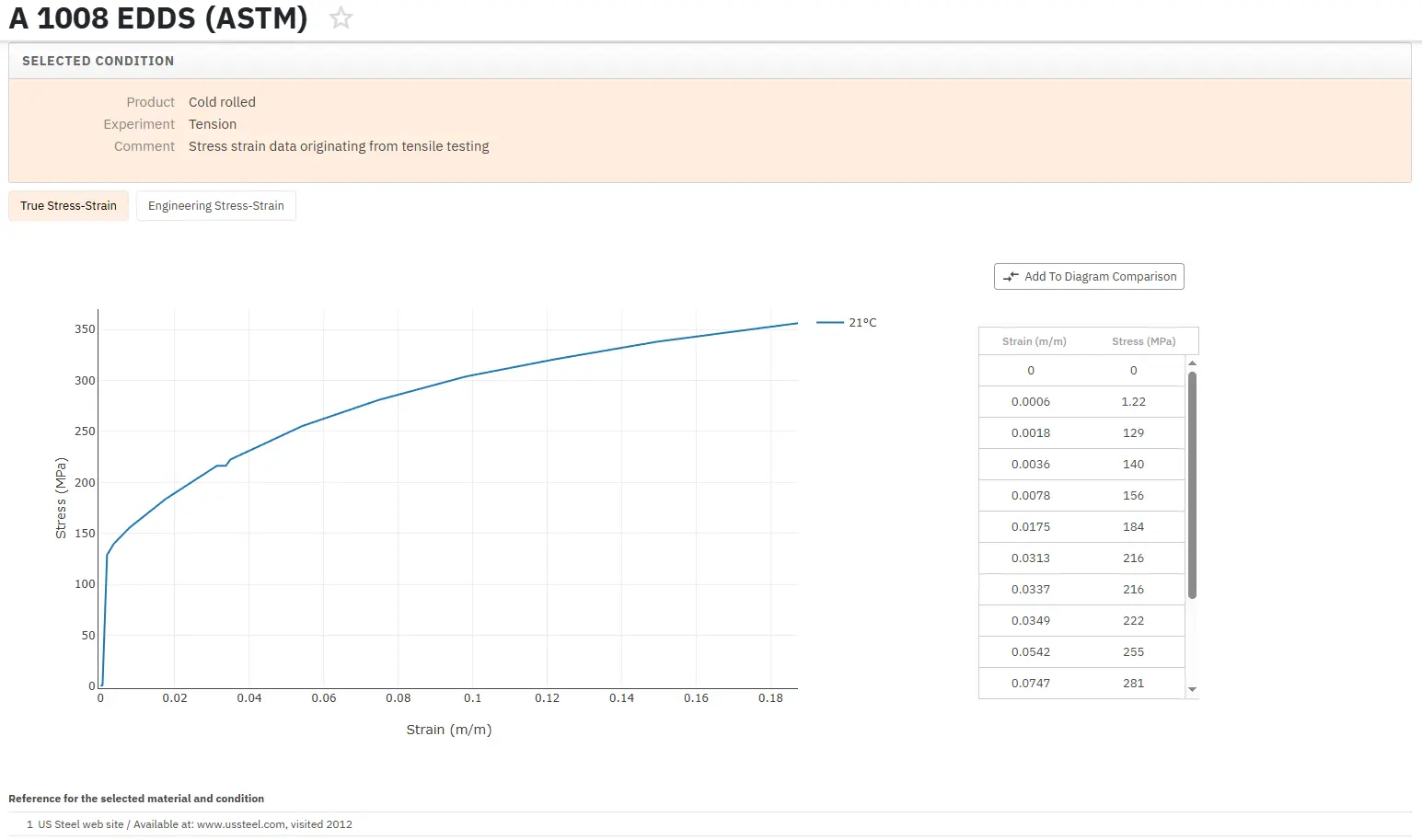High-Strength Low Alloy Steels: New Generation
Abstract
High-strength low-alloy (HSLA) steels, or microalloyed steels, are designed to provide better mechanical properties and/or greater resistance to atmospheric corrosion than conventional carbon steels. They are not considered to be alloy steels in the normal sense because they are designed to meet specific mechanical properties rather than a chemical composition; HSLA steels have yield strengths greater than 275 MPa, or 40 ksi.
High-strength low-alloy (HSLA) steels, or microalloyed steels, are designed to provide better mechanical properties and/or greater resistance to atmospheric corrosion than conventional carbon steels. They are not considered to be alloy steels in the normal sense because they are designed to meet specific mechanical properties rather than a chemical composition; HSLA steels have yield strengths greater than 275 MPa, or 40 ksi.
The chemical composition of a specific HSLA steel may vary for different product thicknesses to meet mechanical property requirements. The HSLA steels in sheet or plate form have low carbon content (C=0.05-0.25 [wt.%]) in order to produce adequate formability and weldability, and they have manganese content up to 2.0%. Small quantities of chromium, nickel, molybdenum, copper, nitrogen, vanadium, niobium, titanium, and zirconium are used in various combinations.
HSLA steels can be divided into six categories:
- Weathering steels, which contain small amounts of alloying elements such as copper and phosphorus for improved atmospheric corrosion resistance and solid-solution strengthening.
- Microalloyed ferrite-pearlite steels, which contain very small (generally, less than 0.10%) additions of strong carbide or carbonitride forming elements such as niobium, vanadium, and/or titanium for precipitation strengthening, grain refinement, and possibly transformation temperature control.
- As-rolled pearlitic steels, which may include carbon-manganese steels but which may also have small additions of other alloying elements to enhance strength, toughness, formability, and weldability.
- Acicular ferrite (low-carbon bainite) steels, which are low-carbon (less than 0.05% C) steels with an excellent combination of high yield strengths (as high as 690 MPa, or 100 ksi) weldability, formability, and good toughness.
- Dual-phase steels, which have a microstructure of martensite dispersed in a ferritic matrix and provide a good combination of ductility and high tensile strength.
- Inclusion-shape-controlled steels, which provide improved ductility and through-thickness toughness by the small additions of calcium, zirconium, or titanium, or perhaps rare earth elements so that the shape of the sulfide inclusions is changed from elongated stringers to small, dispersed, almost spherical globules.
The wide applications of HSLA steels include oil and gas pipelines, heavy-duty highway and off-road vehicles, construction and farm machinery, industrial equipment, storage tanks, mine and railroad cars, barges and dredges, snowmobiles, lawn mowers, and passenger car components. Bridges, offshore structures, power transmission towers, light poles, and building beams and panels are additional uses of these steels.
The choice of a specific high-strength steel depends on a number of application requirements including thickness reduction, corrosion resistance, formability, and weldability. For many applications, the most important factor in the steel selection process is the favorable strength-to-weight ratio of HSLA steels compared with conventional low-carbon steels. This characteristic of HSLA steels has lead to their increased use in automobile components.
The development of high strength steels is shown in Figure 1.

Figure 1: Development of High Strength Steels
As shown in Figure 1, in the seventies, the hot rolling and normalizing was replaced by thermo-mechanical rolling. The latter process enables materials up to X70 to be produced from steels that are microalloyed with niobium and vanadium and have reduced carbon content. By this method, it has become possible to produce higher strength materials like X80, having a further reduced carbon content and excellent field weldability. Additions of molybdenum, copper and nickel enable the strength level to be raised to that of grade X100, when the steel is processed to plate by thermo-mechanical rolling plus modified accelerated cooling.
Natural gas is attracting attention as a source of clean energy because it emits less carbon dioxide than that of petroleum or coal. Furthermore, many long-distance pipelines have been constructed to transport natural gas. In view of these facts, high-strength line pipes X80 up to a strength grade of API 5L X120 are being developed for the purpose of enhancing the transport efficiency of a pipeline by high pressure operation and reducing pipe laying costs by the use of thinner- wall pipes.
In order to arrest running shear fracture and prevent brittle fracture, excellent low-temperature toughness is required of the base metal and the heat affected zone (HAZ) of a welded joint of such a high strength line pipe. In addition, the line pipe is required also to be excellent in weldability in order to improve pipeline construction efficiency. Pipelines constructed in permafrost or seismic regions are subject to a large bending moment caused by ground deformation, and for this reason, large uniform elongation or a low yield ratio has come to be required of a line pipe these years for the purpose of preventing ductile fracture.
The use of X80 line pipe in the construction of the first Ruhrgas X80 pipeline led to a material saving of about 20,000 t, compared with X70 pipes (Fig. 2), through a reduction of the wall thickness from 20.8 mm for X70 to 18.3 mm for X80. This resulted also in a reduction of the pipe laying costs, because of reduced pipe transportation costs and greatly reduced welding costs, as thinner walls meant reduced welding times. The use of materials with still higher strength, such as X100 or X120, could lead to further material savings, as Figure 2 further illustrates.

Figure 2: Possible material savings through use of high-strength material
The Nippon Steel Corporation has succeeded in developing an innovative technology to improve HAZ toughness called Super-High HAZ Toughness Technology with a Fine Microstructure Imparted by Fine Particles (HTUFF)®. By the developed technology, the coarsening of austenite (γ) grains is prevented, and as a result, the microstructure near a welding fusion line (FL) is made remarkably fine.
For improving uniform elongation and yield ratio, it is effective to form a dual-phase microstructure by applying a thermo-mechanical control process (TMCP). On the basis of these technologies, Nippon Steel has developed a new UOE pipe of an X60 to X80 class having excellent HAZ toughness and large uniform elongation called "Tough-Ace". This pipe was used for the Sakhalin pipeline project. Two types of X100 line pipes, namely a high HAZ toughness type and a high uniform elongation type, have also been developed with good results of deformability and the mechanical properties.
Access Precise Properties of Structural Steels Now!
Total Materia Horizon contains property information for 150,000+ structural steels: composition, mechanical and physical properties, nonlinear properties and much more.

Get a FREE test account at Total Materia Horizon and join a community of over 500,000 users from more than 120 countries.